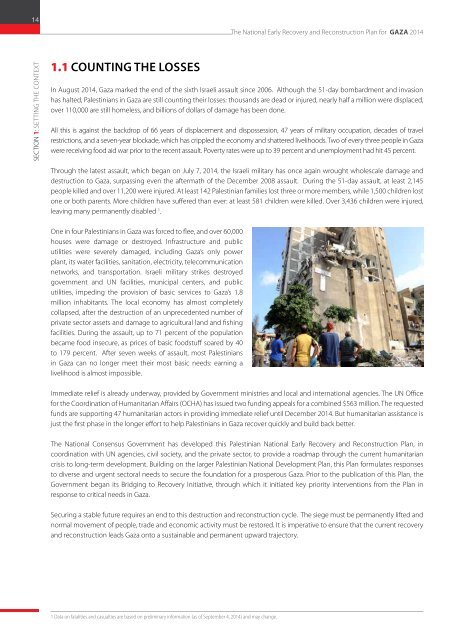National Early Recovery and Reconstruction Plan for Gaza 2014-2017_FINAL
National Early Recovery and Reconstruction Plan for Gaza 2014-2017_FINAL
National Early Recovery and Reconstruction Plan for Gaza 2014-2017_FINAL
Create successful ePaper yourself
Turn your PDF publications into a flip-book with our unique Google optimized e-Paper software.
14The <strong>National</strong> <strong>Early</strong> <strong>Recovery</strong> <strong>and</strong> <strong>Reconstruction</strong> <strong>Plan</strong> <strong>for</strong> <strong>Gaza</strong> <strong>2014</strong>SECTION 1: Setting the Context1.1 Counting the LossesIn August <strong>2014</strong>, <strong>Gaza</strong> marked the end of the sixth Israeli assault since 2006. Although the 51-day bombardment <strong>and</strong> invasionhas halted, Palestinians in <strong>Gaza</strong> are still counting their losses: thous<strong>and</strong>s are dead or injured, nearly half a million were displaced,over 110,000 are still homeless, <strong>and</strong> billions of dollars of damage has been done.All this is against the backdrop of 66 years of displacement <strong>and</strong> dispossession, 47 years of military occupation, decades of travelrestrictions, <strong>and</strong> a seven-year blockade, which has crippled the economy <strong>and</strong> shattered livelihoods. Two of every three people in <strong>Gaza</strong>were receiving food aid war prior to the recent assault. Poverty rates were up to 39 percent <strong>and</strong> unemployment had hit 45 percent.Through the latest assault, which began on July 7, <strong>2014</strong>, the Israeli military has once again wrought wholescale damage <strong>and</strong>destruction to <strong>Gaza</strong>, surpassing even the aftermath of the December 2008 assault. During the 51-day assault, at least 2,145people killed <strong>and</strong> over 11,200 were injured. At least 142 Palestinian families lost three or more members, while 1,500 children lostone or both parents. More children have suffered than ever: at least 581 children were killed. Over 3,436 children were injured,leaving many permanently disabled 1 .One in four Palestinians in <strong>Gaza</strong> was <strong>for</strong>ced to flee, <strong>and</strong> over 60,000houses were damage or destroyed. Infrastructure <strong>and</strong> publicutilities were severely damaged, including <strong>Gaza</strong>’s only powerplant, its water facilities, sanitation, electricity, telecommunicationnetworks, <strong>and</strong> transportation. Israeli military strikes destroyedgovernment <strong>and</strong> UN facilities, municipal centers, <strong>and</strong> publicutilities, impeding the provision of basic services to <strong>Gaza</strong>’s 1.8million inhabitants. The local economy has almost completelycollapsed, after the destruction of an unprecedented number ofprivate sector assets <strong>and</strong> damage to agricultural l<strong>and</strong> <strong>and</strong> fishingfacilities. During the assault, up to 71 percent of the populationbecame food insecure, as prices of basic foodstuff soared by 40to 179 percent. After seven weeks of assault, most Palestiniansin <strong>Gaza</strong> can no longer meet their most basic needs: earning alivelihood is almost impossible.Immediate relief is already underway, provided by Government ministries <strong>and</strong> local <strong>and</strong> international agencies. The UN Office<strong>for</strong> the Coordination of Humanitarian Affairs (OCHA) has issued two funding appeals <strong>for</strong> a combined $563 million. The requestedfunds are supporting 47 humanitarian actors in providing immediate relief until December <strong>2014</strong>. But humanitarian assistance isjust the first phase in the longer ef<strong>for</strong>t to help Palestinians in <strong>Gaza</strong> recover quickly <strong>and</strong> build back better.The <strong>National</strong> Consensus Government has developed this Palestinian <strong>National</strong> <strong>Early</strong> <strong>Recovery</strong> <strong>and</strong> <strong>Reconstruction</strong> <strong>Plan</strong>, incoordination with UN agencies, civil society, <strong>and</strong> the private sector, to provide a roadmap through the current humanitariancrisis to long-term development. Building on the larger Palestinian <strong>National</strong> Development <strong>Plan</strong>, this <strong>Plan</strong> <strong>for</strong>mulates responsesto diverse <strong>and</strong> urgent sectoral needs to secure the foundation <strong>for</strong> a prosperous <strong>Gaza</strong>. Prior to the publication of this <strong>Plan</strong>, theGovernment began its Bridging to <strong>Recovery</strong> Initiative, through which it initiated key priority interventions from the <strong>Plan</strong> inresponse to critical needs in <strong>Gaza</strong>.Securing a stable future requires an end to this destruction <strong>and</strong> reconstruction cycle. The siege must be permanently lifted <strong>and</strong>normal movement of people, trade <strong>and</strong> economic activity must be restored. It is imperative to ensure that the current recovery<strong>and</strong> reconstruction leads <strong>Gaza</strong> onto a sustainable <strong>and</strong> permanent upward trajectory.1 Data on fatalities <strong>and</strong> casualties are based on preliminary in<strong>for</strong>mation (as of September 4, <strong>2014</strong>) <strong>and</strong> may change.


